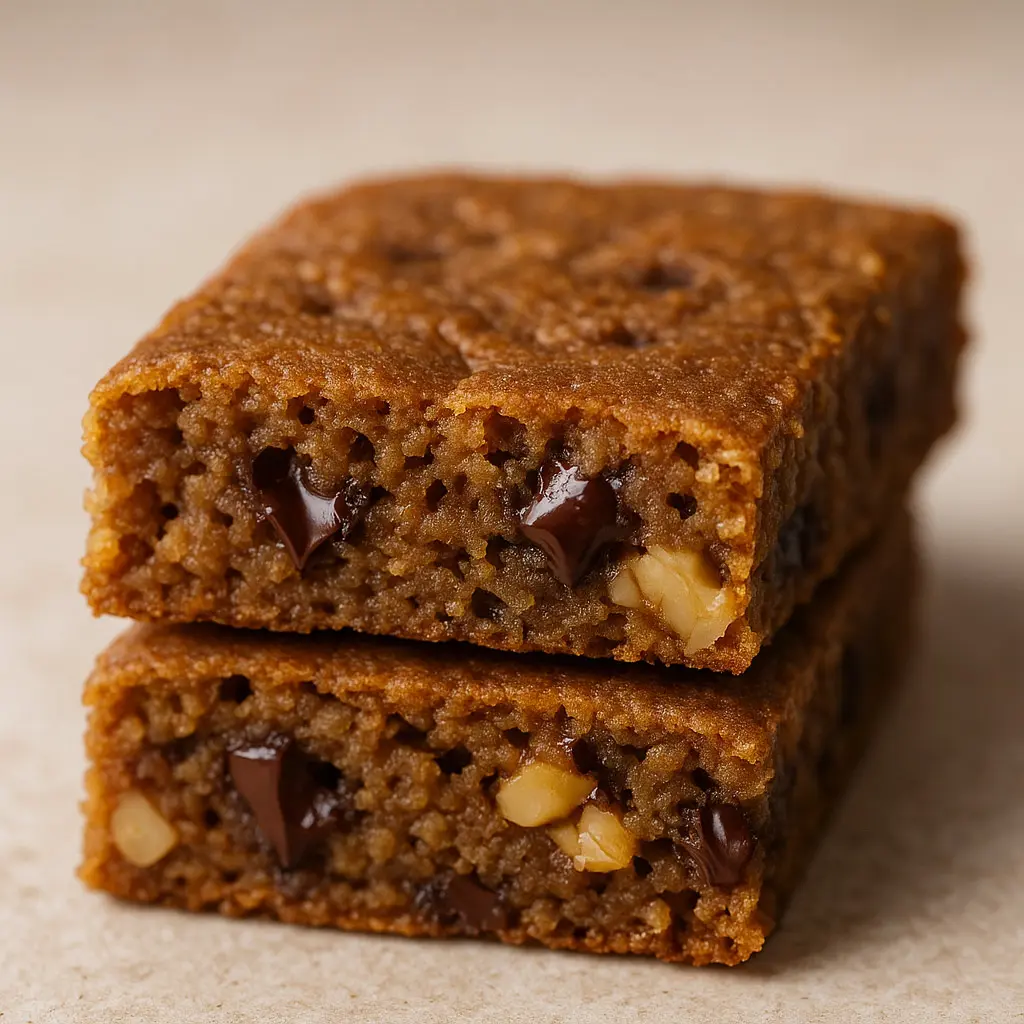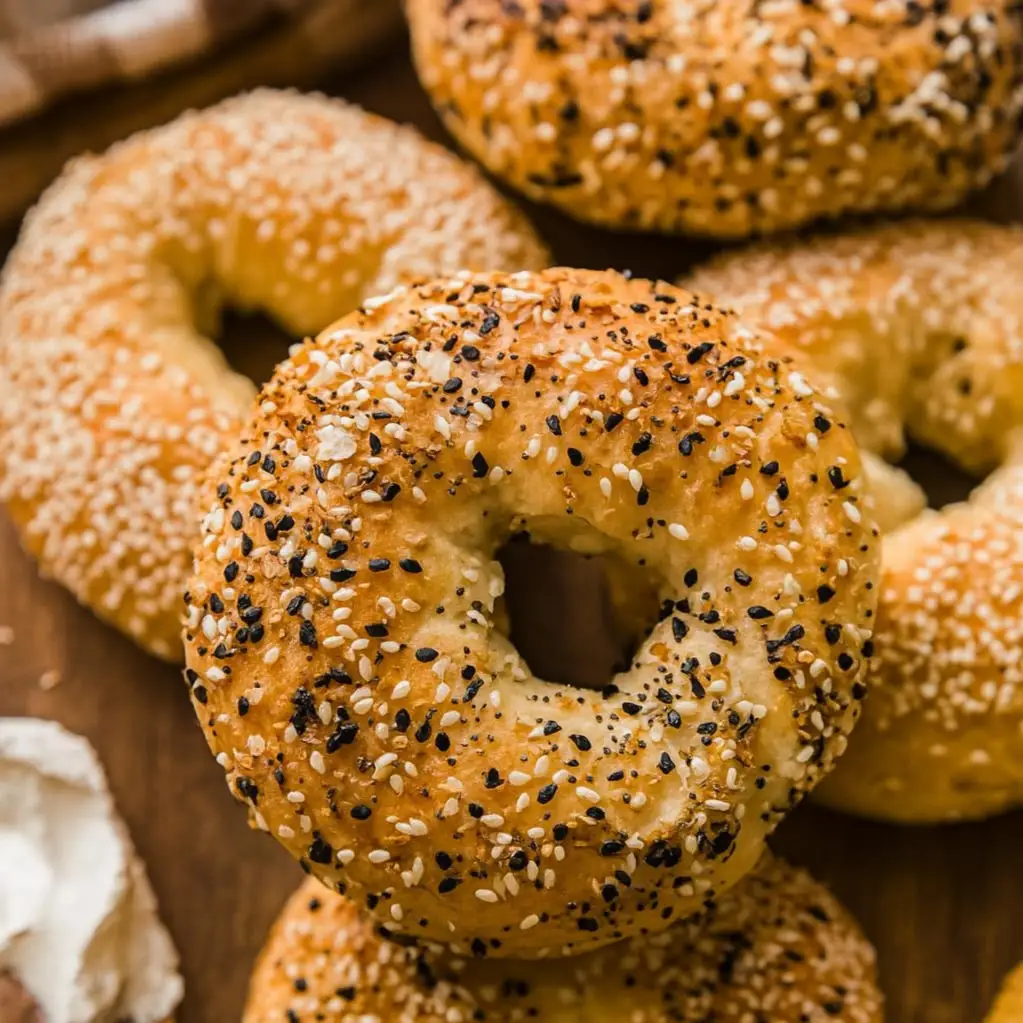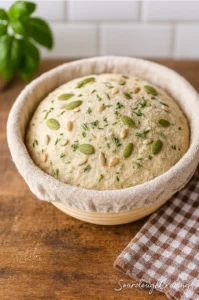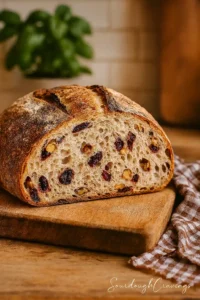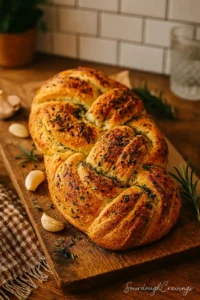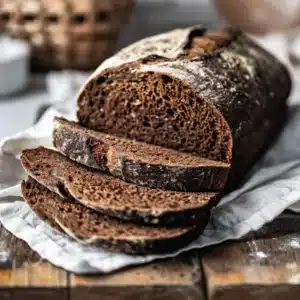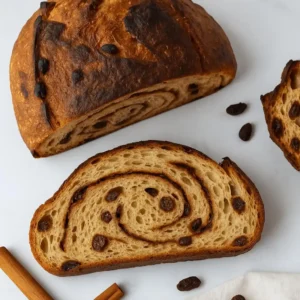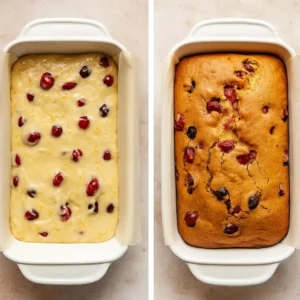The Loaf That Made Me Fall in Love with Savory Sourdough
The first time I made garlic parmesan sourdough, it wasn’t even for me—it was for my neighbor’s lasagna night. I needed something crusty, cheesy, and bold enough to stand up to a bubbling pan of red sauce. So I roasted a few cloves of garlic, grated some good Parmesan, and folded it all into my trusty sourdough base.
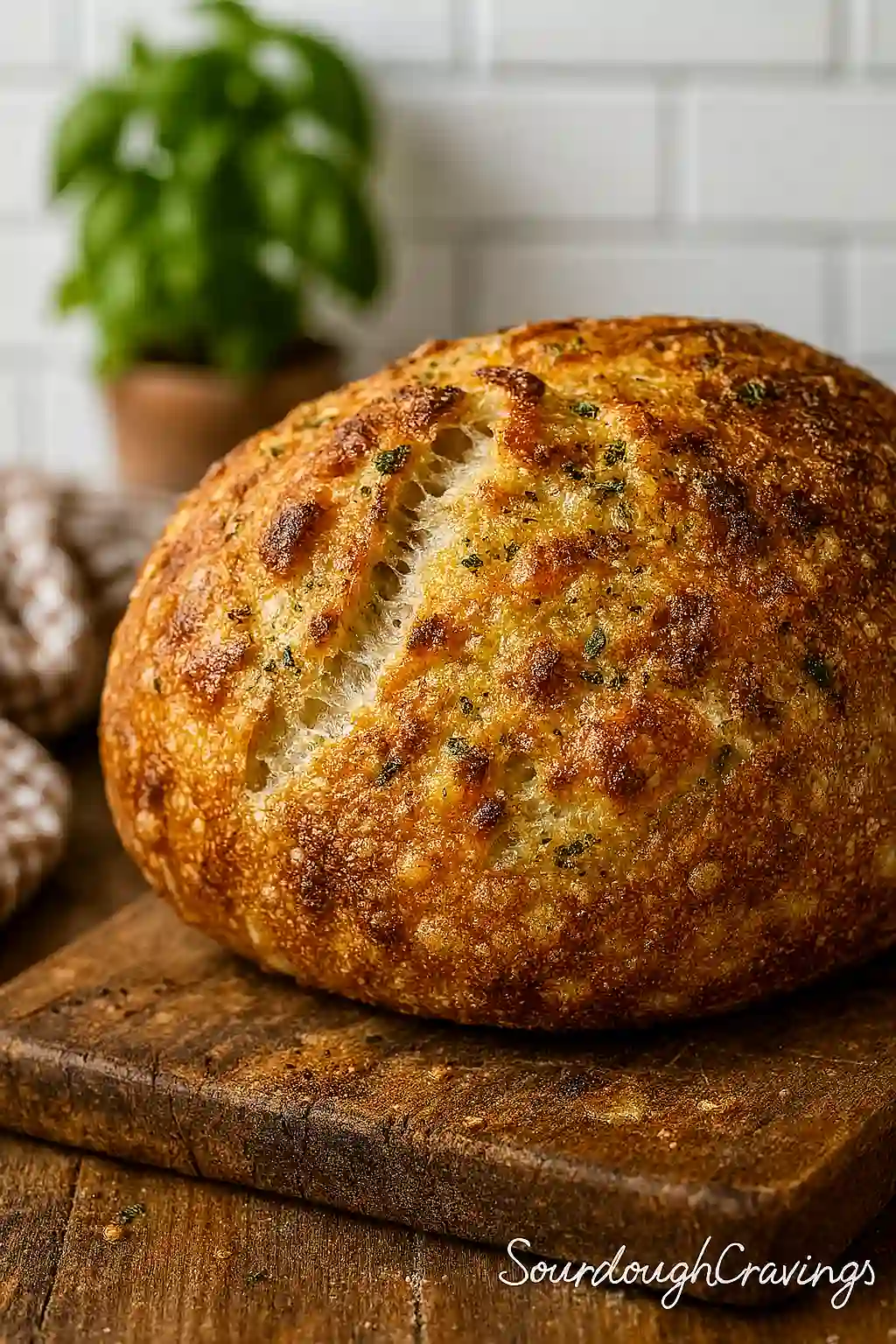
The result? The crust crackled with every slice, releasing an aroma like toasted bliss, while the golden crumb hid gooey bursts of parmesan that melted into each bite—so irresistible, no one stopped at just one piece. I barely got to take a photo.
Now, this garlic parmesan sourdough has become my go-to for anything Italian, anything cheesy, or anytime I want the house to smell like comfort and carbs.
It’s part of my Savory Inclusions Guide for a reason—because when you combine garlic, cheese, and a crusty loaf, magic happens.
There’s something about garlic parmesan sourdough that stops people in their tracks. Maybe it’s the smell—roasted garlic mingling with bubbling cheese and that unmistakable tang of sourdough rising from the oven. Or maybe it’s the flavor, which is bold without being overpowering, indulgent but not too rich.
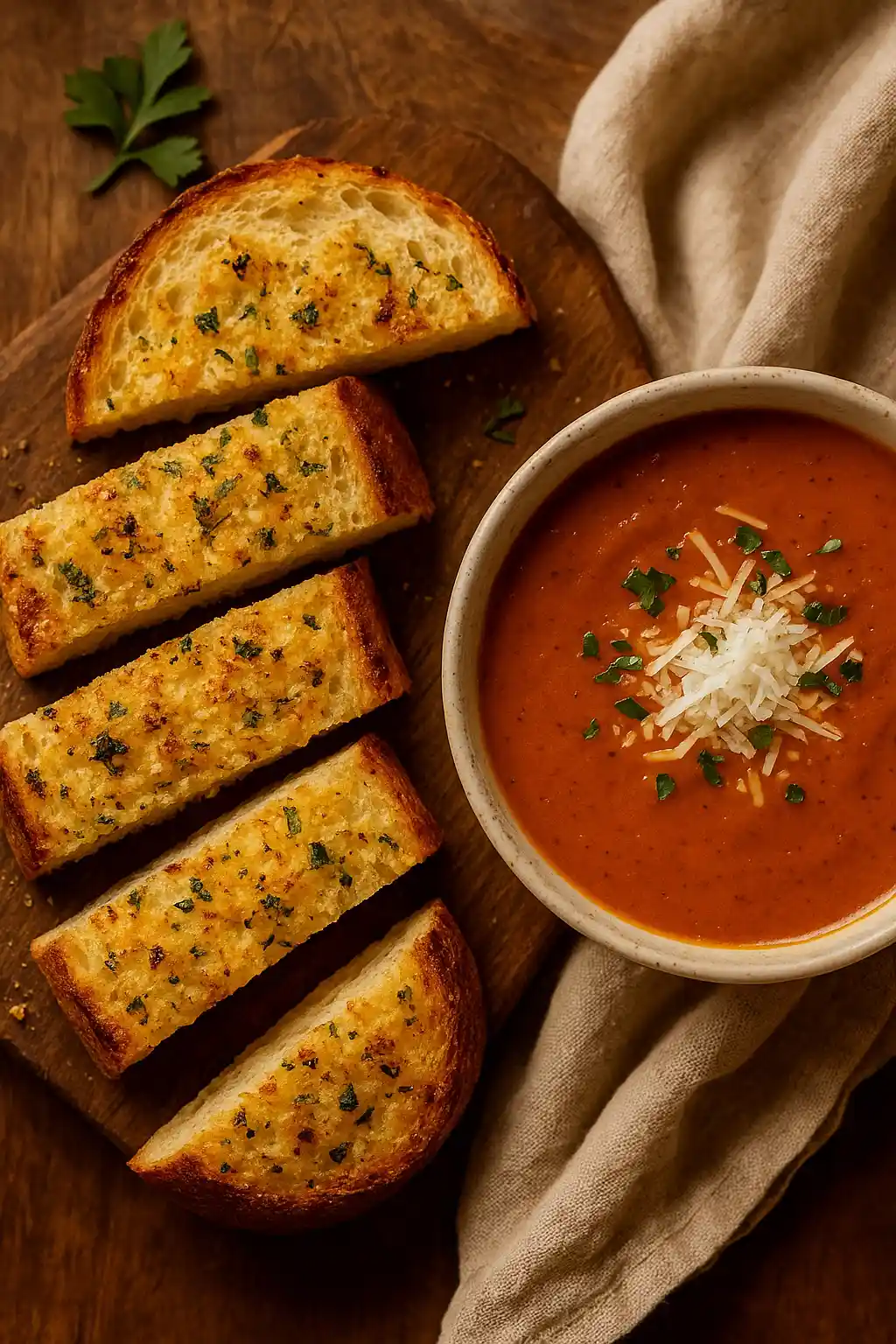
Garlic Parmesan Sourdough
Ingredients
Method
- 1. Mix starter, flour, and 325g water; let rest for 30 minutes (autolyse).

- 2. Add salt and remaining 25g water; mix until smooth.
- 3. Bulk ferment for 4 hours with 3 sets of stretch-and-folds.
- 4. During second fold, laminate in roasted garlic and Parmesan.
- 5. Shape into a boule or batard; place in proofing basket.
- 6. Cold proof in fridge for 12–16 hours.
- 7. Preheat Dutch oven to 475°F.
- 8. Score loaf and bake covered for 22 minutes.
- 9. Remove lid, lower to 450°F, and bake another 20–22 minutes.
- 10. Cool completely on wire rack before slicing.

Nutrition
Notes
Loved this recipe?
Leave a rating & comment. how it was!Table of Contents
The Bold Flavor of Garlic Parmesan Sourdough
Why This Loaf Is Always a Crowd-Pleaser
There’s something deeply comforting about pulling a loaf of garlic parmesan sourdough from the oven. The aroma alone feels like a promise—this meal’s going to be unforgettable. That rich blend of nutty parmesan and caramelized roasted garlic transforms simple sourdough into a crave-worthy, flavor-packed showstopper.
The first time I baked garlic parmesan sourdough, it happened completely by accident. I had a heel of Parm in the fridge, a few cloves of garlic just starting to sprout, and a bubbling starter begging to be used. I chopped, folded, and hoped for the best. What came out was a golden loaf that crackled as it cooled and filled the kitchen with pure savory joy.
Now, I bake garlic parmesan sourdough whenever I want to impress with minimal effort. Whether I’m serving it with baked ziti, creamy tomato soup, or just olive oil and sea salt, it never disappoints.
Pairing Garlic & Parmesan in Naturally Leavened Bread
What makes garlic parmesan sourdough so irresistible is the contrast—pillowy softness against a crackling crust, mellow garlic warmth balanced by sharp, salty cheese. Roasting the garlic before adding it to the dough mellows the flavor and keeps it from overpowering the tang of sourdough. Meanwhile, aged parmesan adds depth, saltiness, and those little crisp cheese edges I dream about.
I’ve found the perfect balance is around 15% roasted garlic and 15–20% grated parmesan based on total flour weight. This keeps the texture of the dough light, while packing in big flavor. Add them during lamination or late stretch-and-folds to keep the structure intact.
If you’ve ever wished your bread had the soul of garlic bread but the structure of a true artisan loaf, garlic parmesan sourdough is your answer. It’s not just bread—it’s a conversation starter, a comfort food, and one of my favorite ways to turn everyday dinners into something memorable.
Garlic Parmesan Sourdough Add-Ins: What Works Best
Choosing the Right Cheese (Grated, Shaved, or Cubed?)
When it comes to building flavor in garlic parmesan sourdough, the cheese you choose makes all the difference. Parmesan brings that signature salty, nutty vibe—but not all parmesan forms behave the same way in the oven. I’ve tested everything from hand-shaved Parm to those bags of pre-grated cheese, and let me tell you, not all options are created equal.
Grated parmesan melts quickly and disperses evenly throughout the dough. It ensures every bite delivers the same rich, consistent flavor throughout. Shaved parmesan gives you bold, cheesy pockets that create little “surprise melty zones.” Cubed parmesan, while tempting, often melts too slowly and can leave large gaps or oily streaks.
For a balanced garlic parmesan sourdough, I use freshly grated Parmigiano Reggiano—about 15–20% of total flour weight. It blends seamlessly during lamination, baking into a golden, toasty finish without becoming oily or heavy.
📊 Cheese Type Comparison:
| Type | Texture in Bread | Recommended? |
|---|---|---|
| Grated Parmesan | Even melt, bold flavor | ✅ Best choice |
| Shaved Parmesan | Pockets of melted cheese | 👍 Use sparingly |
| Cubed Parmesan | Inconsistent melt, can leak | ❌ Not ideal |
📌 Best parmesan types for garlic parmesan sourdough texture
Raw vs. Roasted Garlic: Flavor and Fermentation Tips
Now let’s talk garlic. For garlic parmesan sourdough, roasted garlic is the gold standard. It adds depth and sweetness without overpowering the sourdough’s natural tang. Raw garlic tends to be overpowering and can disrupt the fermentation process if not handled carefully.
I roast a whole bulb, mash the cloves into a paste, and add it during the second fold. That way, it blends into the dough beautifully without tearing it. The flavor of roasted garlic caramelizes during baking and enhances the crust.
If you loved the simplicity of Garlic Herb Sourdough, this version takes it a step further with richness and body.
The key to great garlic parmesan sourdough is balance: bold flavors folded gently into a dough that still breathes, springs, and bakes to crusty perfection.
How to Make Garlic Parmesan Sourdough (Step-by-Step)
Lamination vs. Fold-In: When to Add Cheese and Garlic
There are two ways to add inclusions to your garlic parmesan sourdough—and they each create slightly different results. For maximum flavor pockets and visual appeal, I prefer lamination. It gives you evenly spread garlic and cheese without overworking the dough. If you’re short on time or your dough is very wet, the late stretch-and-fold method also works.

After the first 30 minutes of bulk fermentation, I lightly stretch the dough on my counter and spread a layer of roasted garlic paste and freshly grated parmesan (about 15–20% of flour weight). Then I fold it in thirds like a letter and continue with stretch-and-folds as usual.
Trust me, the flavor payoff in garlic parmesan sourdough is so worth it. You’ll end up with cheesy layers and garlicky ribbons throughout the loaf—no sad empty bites.
Cold Proofing and Steam for Optimal Crust
After shaping, I cold-proof the dough in the fridge for 12 to 16 hours. This allows the garlic and parmesan to integrate into the dough structure without breaking it down or over-fermenting. I bake it in a Dutch oven to lock in steam, giving the loaf time to fully expand before the crust crisps up.

Because garlic parmesan sourdough has oil and sugar content from the roasted garlic, you want to watch your bake time carefully. I bake mine at 475°F (covered) for 22 minutes, then uncover and reduce to 450°F for 20–22 more, checking for that dark golden crust and cheesy crispness around the scoring.
You know it’s perfect when the house smells like roasted heaven and your crust has those tiny parmesan “frico” bubbles baked into the surface.
Hydration Calculator for Garlic Parmesan Sourdough
Use this tool to estimate how much water to use based on how much cheese you’re adding.
💧 Recommended hydration: 70%
📌 Use this slider to balance cheese additions and hydration in garlic parmesan sourdough
Baking, Scoring & Flavor Boosting
Bake Times for Cheese Loaves
Baking garlic parmesan sourdough is a little different than baking a plain sourdough boule. You’ve got melty cheese involved—which means your crust can go from perfectly caramelized to burnt-cheese brittle in no time. Trust me, I’ve learned the hard way (RIP to that one very smoky batch).
Here’s what works for me:
- Preheat your Dutch oven to 475°F
- Bake covered for 22 minutes
- Uncover and reduce heat to 450°F
- Bake for an additional 20–22 minutes
This gives garlic parmesan sourdough that golden, blistered exterior with deeply caramelized cheese edges—without tipping over into bitterness. If you see the parmesan starting to blacken, tent the loaf with foil and finish the bake covered.
Scoring is another flavor moment. A bold slash gives steam room to escape and lets cheese bubble out from beneath the surface. Just be prepared: the loaf might look a little wild, and that’s a good thing.
When Garlic Burns and How to Avoid It
The one risk with garlic parmesan sourdough is burning your garlic. Raw garlic scorches easily and can leave harsh, acrid notes in an otherwise perfect loaf. That’s why I always roast it first—just slice the top off a bulb, drizzle with olive oil, wrap in foil, and bake at 400°F for 35–40 minutes.
After it’s softened, mash it into a smooth paste and gently incorporate it into the dough. It blends beautifully and stays sweet even in a hot oven. Bonus tip: roasted garlic also helps reduce gluten damage during folding, which can help maintain dough strength.
If you want a deeper dive into how cheese behaves during baking, I highly recommend this article by King Arthur Baking. It breaks down which cheeses melt, crisp, or ooze—and how to bake around each type.
📈 Cheese Burn Risk by Temperature
| Temperature (°F) | Cheese Burn Risk |
|---|---|
| 425°F | Low |
| 450°F | Medium |
| 475°F+ | High |
📌 Cheese burn risk by baking temperature in garlic parmesan sourdough
What Garlic Parmesan Sourdough Pairs Well With
When I think about serving garlic parmesan sourdough, I imagine family dinners around big bowls of pasta, a pot of roasted tomato soup bubbling on the stove, or a picnic basket packed with herby dips and cured meats.
The bold, cheesy profile of this sourdough makes it the perfect sidekick for anything rich or saucy. I love slicing it thick and pairing it with baked ziti, a drizzle of olive oil, or even garlic butter (yes, more garlic—always). And when it’s a day old? Toast a slice, swipe it with raw garlic, then finish with creamy cheese or a perfectly poached egg.
If you’re into spicy, savory loaves, this is a delicious alternative to my Jalapeño Cheddar Sourdough, but with a slightly nuttier finish thanks to the parmesan.
You can even get creative—turn leftovers into grilled cheese, crostini, or homemade croutons. However you serve it, garlic parmesan sourdough makes every meal feel like an occasion.
Storing Garlic Parmesan Sourdough Without Losing Crunch
Let’s be honest—garlic parmesan sourdough is best fresh. That crackly crust, cheesy aroma, and soft center? Absolute perfection on bake day. But if you’ve got leftovers (lucky you), there are a few tricks to help you keep the magic alive.
I like to store mine cut side down on a wooden board and cover it with a clean tea towel for the first 24 hours. After that, it goes into a paper bag tucked inside a bread box to help balance airflow and moisture.
Avoid plastic—it traps humidity and ruins the crust. You worked hard for that parmesan crisp, don’t let it get soggy!
And if you’re freezing it? Slice it first. That way, you can toast individual pieces straight from the freezer without reheating the whole loaf.
📊 Storage Method Comparison for Garlic Parmesan Sourdough:
| Storage Method | Crust Retention | Best For |
|---|---|---|
| Cut side down on board (covered) | Excellent (first 24 hrs) | Same-day freshness |
| Paper bag + bread box | Good (1–2 days) | Short-term storage |
| Plastic bag or wrap | Poor | Not recommended |
📌 Best ways to store garlic parmesan sourdough and preserve crust
Frequently Asked Questions About Garlic Parmesan Sourdough
Can I use garlic powder instead of roasted garlic in garlic parmesan sourdough?
Yes, you can use garlic powder in a pinch, but it won’t deliver the same rich, sweet depth that roasted garlic brings. If using powder, reduce the amount to avoid overpowering the dough. For best results, stick with mashed, roasted garlic when making garlic parmesan sourdough—it blends beautifully without bitterness.
What type of parmesan works best for garlic parmesan sourdough?
Freshly grated Parmigiano Reggiano is ideal. It melts evenly, adds bold umami flavor, and creates that irresistible crispy crust. Pre-shredded cheese can be used, but it often contains anti-caking agents that affect melt quality. For a show-stopping garlic parmesan sourdough, stick with the real deal and grate it yourself.
How much cheese and garlic should I use in the dough?
A good rule of thumb is 15–20% parmesan and 10–15% roasted garlic based on total flour weight. This gives you strong flavor without compromising dough structure. Adding too much can weigh down your garlic parmesan sourdough, so measure carefully and incorporate add-ins during lamination or the second fold.
Why does the cheese sometimes burn on top of the crust?
Parmesan melts fast and can crisp up quickly at high temperatures. If you add too much near the surface or score too deeply, it might bubble out and burn. Bake garlic parmesan sourdough covered for the first 20–22 minutes, then reduce heat and uncover to finish—this helps control crust color and prevent over-browning.



